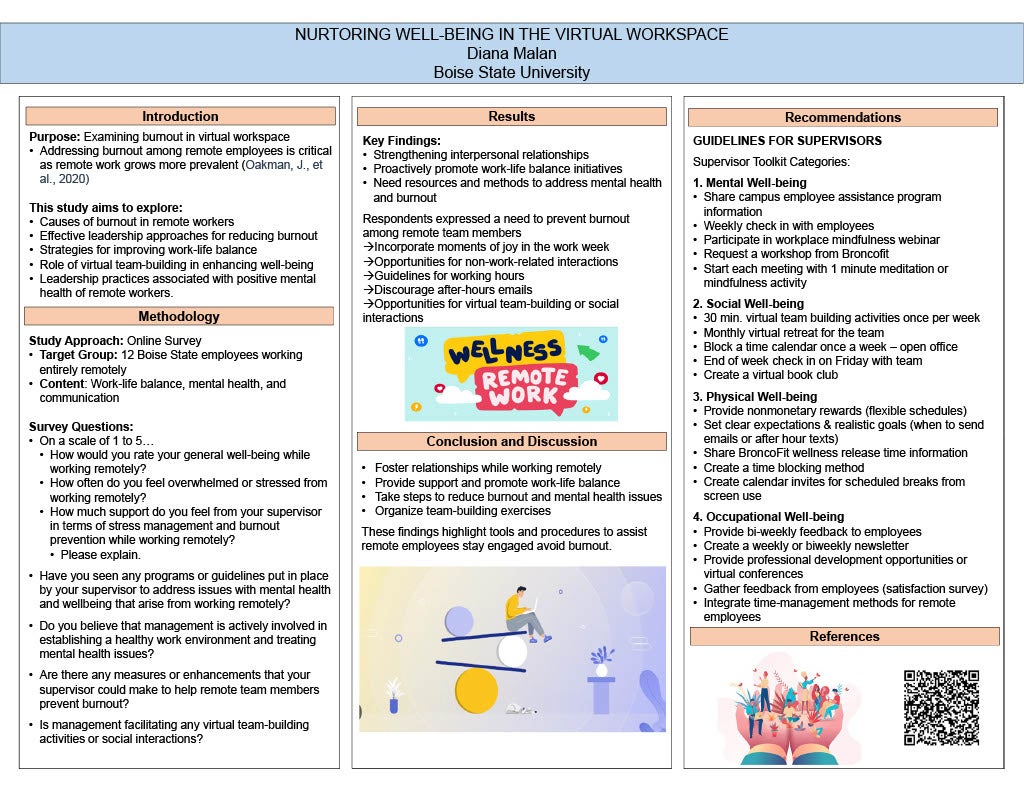Nurturing Well-being in the Virtual Workspace: Diana Malan’s Deep Dive into the Remote Workspace
In the ever-evolving work landscape, remote employment has become a strategic solution for many organizations. Boise State University’s Diana Malan, a passionate advocate for employee well-being, has dedicated herself to understanding and enhancing the virtual work experience.
Diana’s journey began with a question: How can we ensure that remote work is not only efficient but also sustainable for employees? Her research dug into the causes of burnout, effective leadership strategies, work-life balance techniques, and the role of virtual team-building. The findings were enlightening.
She discovered that people thrive on connection, even in virtual spaces. She suggests that supporting remote employees goes beyond logistical solutions to foster a sense of belonging and well-being, which helps to prevent burnout.
Her recommendations for supervisors reflect this ethos, offering practical yet impactful actions to support remote teams. From regular check-ins and virtual team-building activities to clear communication and mental health resources, Diana’s guidelines are designed to create a supportive and inclusive virtual workspace.
But Diana’s mission extends beyond guidelines; it advocates for a cultural shift. It’s about recognizing remote work as a valuable component of the modern workforce and integrating well-being practices into strategic planning.
Diana looks to the future with this insight:
I want to create more programs for employee well-being and share different ideas with supervisors about supporting remote employees. Diana Malan
Remote work is not just a temporary fix; it’s a strategic opportunity. Prioritizing employee well-being and addressing burnout is an investment in your team’s future resilience.
As organizations embrace remote work as a long-term strategy, it’s crucial to recognize the importance of employee well-being. By incorporating discussions about burnout and mental health into strategic plans, leaders can create a more sustainable and fulfilling work environment for all.
By nurturing well-being in the virtual workspace, we’re paving the way for a future where remote work is a pillar of organizational success.
Poster: Nurtouring Well-Being in the Virtual Workspace
Take a look at her work. Image of poster is available and a text description is also provided.

Introduction
Purpose: Examining burnout in virtual workspace. Addressing burnout among remote employees in critical as remote work growns more prevalents (Oakman, J., et al., 2020)
This study aims to explore:
- Causes of burnout in remote workers
- Effective leadership approaches for reducing burnout
- Strategies for improving work-life balance
- Role of virtual team-building in enhancing well-being
- Leadership practices associated with positive mental health of remote workers
Methodology
Study approach
Online survey
- Target group: 12 Boise State employees working entirely remotely
- Content: work-life balance, mental health, and communication
Survey questions
- On a scale of 1 to 5: How would you rate your general well-being while working remotely? How often do you feel overwhelmed or stressed from working remotely? How much support do you feel from your supervisor in terms of stress management and burnout preventions while working remotely? Please explain
- Have you seen any programs or guidelines put in place by your supervisor to address issues with mental health and wellbeing that arise from working remotely?
- Do you believe that management is actively involved in establishing a health work environgment and treating mental health issues?
- Are there any measures or enhancements that your supervisor could make to help remote team members prevent burnout?
- Is management facilitating any virtual team-building activities or social interactions?
Results
Key Findings
- Strengthening interpersonal relationships
- Proactively promote work-life balance initiatives
- Need resources and methods to address mental health burnout
Respondents expressed a need to prevent burnout among remote team members
- Incorporate moments of joy in the work week
- Opportunities for non-work-related interactions
- Guidelines for working hours
- Discourage after-hours emails
- Opportunities for virtual team-building or social interactions
Conclusion and Discussion
- Foster relationships while working remotely
- Provide support and promote work-life balance
- Take steps to reduce burnout and mental health issues
- Organize team-building exercises
These findings highlight tools and procedures to assist remote employees stay engaged avoid burnout.
Recommendations
Guidelines for Supervisors
Supervisor Toolkit Categories:
1. Mental well being
- Share campus employee assistance program information
- Weekly check in with employees
- Participate in workplace mindfullness webinar
- Request a workshop from Broncofit
- Start each meeting with 1 minutes meditation or mindfullness activity
2. Social well-being
- 30 min virtual team building activities once per week
- Monthly virtual retreat for the team
- Block a time on calendar once a week — open office
- End of week check in on Friday with team
- Createa virtual book club
3. Physical well-being
- Provide nonmonetary rewards (flexible schedules)
- Set clear expectations and realistic goals (when to send emails or after hours texts)
- Share BroncoFit wellness release time information
- Create a time blocking method
- Create calendar invites for scheduled breaks from screen use
4. Occupational well-being
- Provide bi-weekly feedback to employees
- Create a weekly or biweekly newsletter
- Provide professional development opportunities or virtual conferences
- Gather feedback from employees (satisfaction survey)
- Integrate time-management methods for remote workers